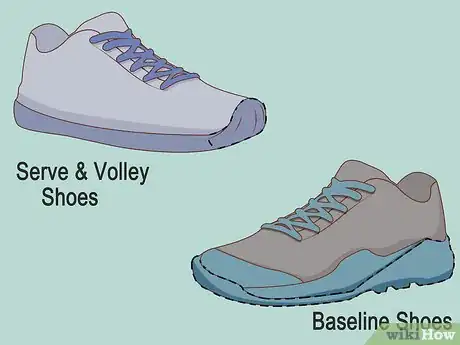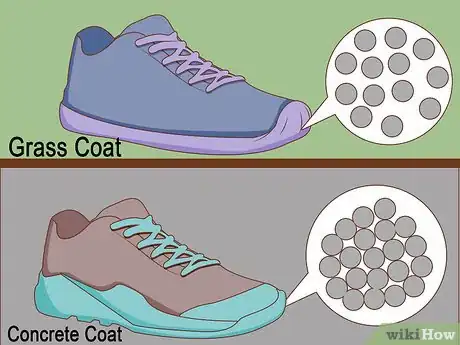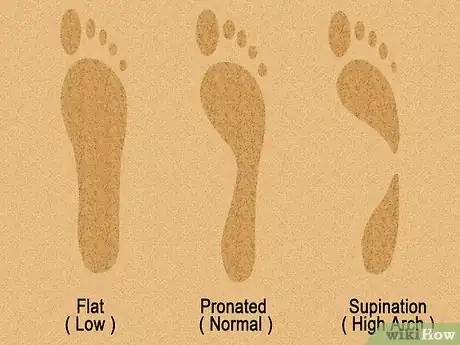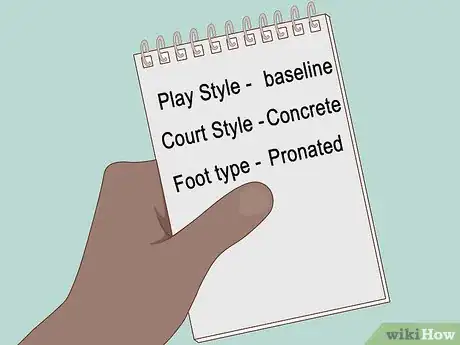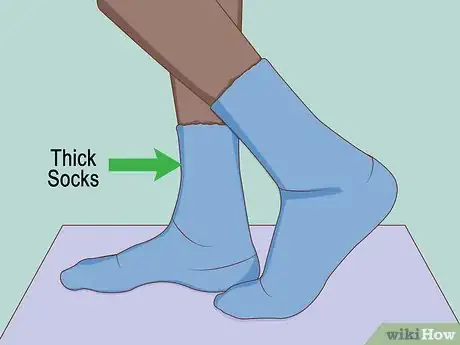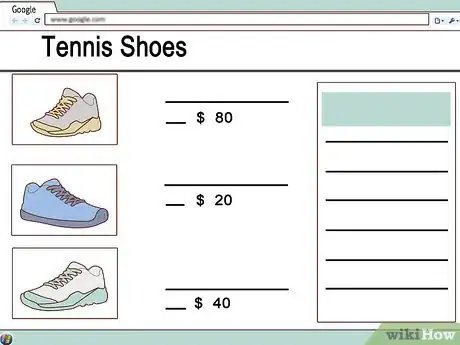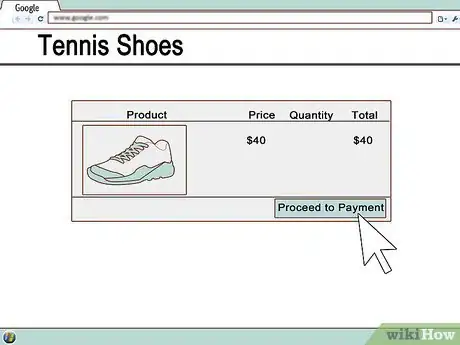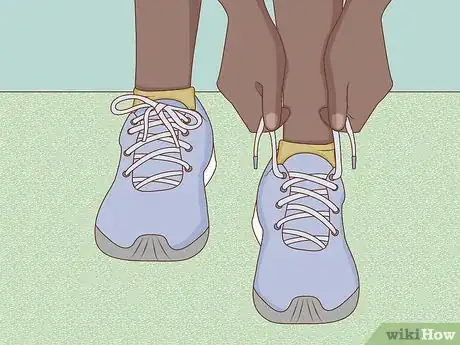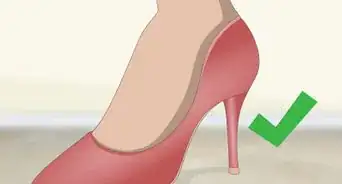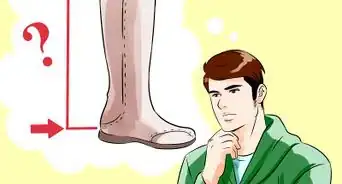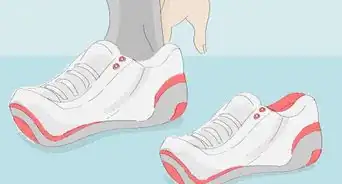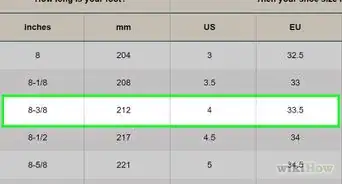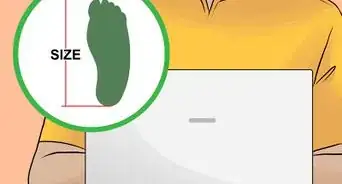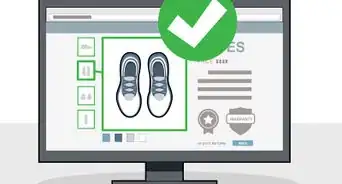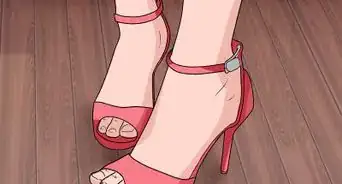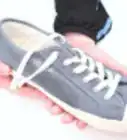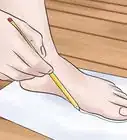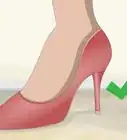This article was co-authored by Peter Fryer. Peter Fryer is a tennis writer and coach based in Derry Northern Ireland. He completed his professional teaching tennis qualification shortly after finishing university and has been teaching tennis for over 13 years. Peter began Love Tennis Blog in 2010 and contributes to the BBC and national media outlets.
This article has been viewed 41,429 times.
Tennis is a sport that requires considerable agility and coordination. The constant back-and-forth nature of tennis play and the need to switch directions while running means that for avid tennis players, shoes are the fastest thing to wear out. Regular trainers just won't cut it—they do not offer the needed ankle or heel protection. By extension, a well-chosen tennis shoe will help players endure the stress of playing well. When deciding to buy tennis shoes, you will need to take your play style, court surface and foot type into consideration to find your best fit.
Steps
Determining How and Where You Play
-
1Figure out what kind of tennis player you are. Typically players are either "serve and volley," who charge the net and slide their back foot while serving, or "baseline," who generally play along the back line. Since these two types move differently on the court, they wear shoes out differently.[2]
- Choose a shoe with a toecap if you're a "serve and volley" player.
- Buy shoes with lots of lateral support and a durable sole if you run from side to side a lot.[3]
-
2Determine your most frequent court surface type. The harder the court surface, the more durable the sole should be. Using the right sole for the right court surface can prolong the life of your shoes, offer the right amount of traction and prevent court surface damage.[4]Advertisement
-
3Pick the right sole for the surface. Hard surfaces wear shoes out faster. Shoes made for concrete are more durable and made with tougher materials, while others are more flexible.
- For clay or grass courts, the soles may not be as durable, but they are designed to provide traction without damaging the court.
- Multi-court shoes are also available that adapt well for a variety of surfaces.
- Shoes with a herringbone style outer sole work especially well for clay. The narrow treading helps grip the floor and prevent loose grains on the surface from entering the sole and smoothing it out.[5]
Knowing Your Foot Type and Shoe Fit
-
1Determine your foot type. This is arguably the most important step in choosing the right tennis shoe. Your foot type will determine how much lateral support and cushioning you will need for optimal safety and comfort.[6]
- Use the "wet test" to determine your foot type. Wet the soles of your foot and step onto a flat surface, such as a piece of construction paper or the sidewalk. Look at the area between the ball of the foot and the heel of the foot.
- A large gap indicates a high arch, which means your feet are supinated.
- No gap at all indicates flat feet, which means your feet are pronated.
- If your feet are in between, then they are neutral.
- For supinated feet: Opt for a more flexible shoe. You will experience most wear and tear around the heel and toes.[7]
- For pronated feet: Buy a stabilizing tennis shoe, since you will experience most wear and tear around the front inside area of your foot.
- For neutral feet: You can try just about any shoe.
- Use the "wet test" to determine your foot type. Wet the soles of your foot and step onto a flat surface, such as a piece of construction paper or the sidewalk. Look at the area between the ball of the foot and the heel of the foot.
-
2Determine cushioning material type. Tennis shoes are made with 2 types of cushions: EVA and PU. EVA cushions are lighter and more flexible, but offer less stability and durability. PU cushions are more durable and stable, but tend to be heavier.[8]
-
3Make a list. Putting together a list of your play style, court style and foot type will help you figure out what kind of shoes you should be shopping for, so you don't waste your time trying on tennis shoes that won't work for you.
-
4Consider sizing up. Remember that feet tend to swell a bit during exercise and you may be wearing thicker socks than normal.
Picking Your Shoes
-
1Do some research. Knowing what kind of sole and how much stability you need, based on court type, playing style and foot type will go a long way. Determine how much the kind of shoes you're looking for tend to cost.
- Even if budget is a factor, buying the best shoes you can afford will help protect your feet and ensure your shoes last as long as possible. Remember that purchasing tennis shoes is an investment. It will reduce your chances of succumbing to injury.
- Shopping around and visiting different stores and websites can help you find the best deal.
- In general, you get what you pay for, and $80 shoes will be higher quality and last longer than $15 shoes—but paying big bucks for celebrity-endorsed shoes may not be worth it.
-
2Make your purchase. After you've figured out what kind of shoes you need, the brand and style you like, and where the best deal can be found, it's time to buy!
- Unlike leather shoes, most tennis shoes do not need to be "broken in" and should feel ready to play in when you try them on. They should fit snugly but not so tightly they will chafe.[10]
- Stores specializing in athletic shoes may have employees who can recommend brands and styles that will work well for you.
- If you're ordering shoes online, be sure you know the site's return policy and how to return shoes that don't work for you.
-
3Enjoy your shoes. See how your shoes work in action on the court and make sure you're fully satisfied with your purchase.
Community Q&A
-
QuestionWhat type of tennis shoes are recommended while healing from a severe sprained ankle?
 Community AnswerTry to get something with support, preferably Asics or New Balance. Also, make sure it has a white bottom and the ability to quickly stop while not hurting your ankle.
Community AnswerTry to get something with support, preferably Asics or New Balance. Also, make sure it has a white bottom and the ability to quickly stop while not hurting your ankle. -
QuestionWhen to purchase new shoes?
 Community AnswerWhen you need or want them. Definitely buy new shoes if your old ones are starting to fall apart. But you can buy new shoes whenever you want as long as you can afford it.
Community AnswerWhen you need or want them. Definitely buy new shoes if your old ones are starting to fall apart. But you can buy new shoes whenever you want as long as you can afford it. -
QuestionAre leather tennis shoes desireable?
 Community AnswerIt's really a matter of taste, but leather tennis shoes can be more durable than canvas or fabric, and will mold to your foot after wearing them for a while.
Community AnswerIt's really a matter of taste, but leather tennis shoes can be more durable than canvas or fabric, and will mold to your foot after wearing them for a while.
Warnings
- Don't substitute other kinds of athletic shoes. Tennis shoes are made with flatter soles that are more durable and meant for the back-and-forth motion, while running shoes have softer, more highly cushioned soles meant for forward motion.⧼thumbs_response⧽
- Tennis shoes will feel heavy relative to other shoes. This is normal—the weight can often indicate that the shoes offer protection.⧼thumbs_response⧽
References
- ↑ www.optimumtennis.net/tactics-of-tennis.htm
- ↑ www.myactivesg.com/Sports/Tennis/How-To-Play/Tennis-Equipment/How-to-choose-your-tennis-shoes
- ↑ www.walkerscart.com/questions-ask-choosing-tennis-shoes/
- ↑ www.myactivesg.com/sports/tennis/how-to-play/tennis-equipment/how-to-choose-your-tennis-shoes
- ↑ www.webmd.com/fitness-exercise/features/how-choose-athletic-shoes#1
- ↑ www.marshfieldclinic.org/sports-wrap/choosing-athletic-shoes
- ↑ www.walkerscart.com/questions-ask-choosing-tennis-shoes/
- ↑ www.myactivesg.com/sports/tennis/how-to-play/tennis-equipment/how-to-choose-your-tennis-shoes
